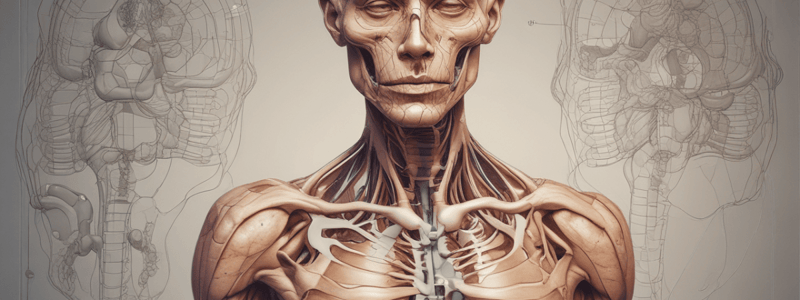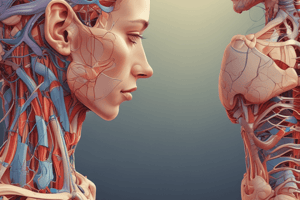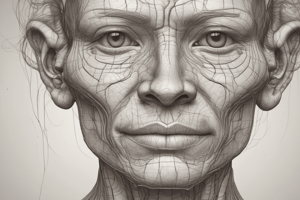Podcast
Questions and Answers
What occurs in hyper-pigmentation?
What occurs in hyper-pigmentation?
- The skin lightens in color
- The skin darkens in color
- The skin remains the same color but melanocytes produce more melanin (correct)
- The skin becomes transparent
What is tested through the skin fold in palpation and mobilization?
What is tested through the skin fold in palpation and mobilization?
- Skin temperature
- Skin texture
- Skin mechanical properties (correct)
- Skin elasticity
What is an indicator of trophism and blood supply?
What is an indicator of trophism and blood supply?
- Pulse (correct)
- Skin humidity
- Skin temperature
- Skin secretion
What is a type of disorder related to skin secretion?
What is a type of disorder related to skin secretion?
What is a characteristic of atrophic skin?
What is a characteristic of atrophic skin?
What is a test used to diagnose lymphedema?
What is a test used to diagnose lymphedema?
Which layer of the skin provides mechanical protection?
Which layer of the skin provides mechanical protection?
What is the function of sebaceous glands in the skin?
What is the function of sebaceous glands in the skin?
What type of sensory receptors are located in peripheral tissues such as skin, superficial fascia, tendons, and joint capsules?
What type of sensory receptors are located in peripheral tissues such as skin, superficial fascia, tendons, and joint capsules?
Which layer of the epidermis is characterized by the presence of keratin-filled cells?
Which layer of the epidermis is characterized by the presence of keratin-filled cells?
What is the function of melanin-producing cells in the skin?
What is the function of melanin-producing cells in the skin?
Which type of thermoreceptors respond to temperatures above 45 degrees Celsius?
Which type of thermoreceptors respond to temperatures above 45 degrees Celsius?
What is the primary function of the sebaceous secretion in the skin?
What is the primary function of the sebaceous secretion in the skin?
What is the term used to describe the absence of perception in the skin?
What is the term used to describe the absence of perception in the skin?
Which type of sensory receptor is responsible for detecting vibrations in the skin?
Which type of sensory receptor is responsible for detecting vibrations in the skin?
What is the term used to describe the ability to perceive the position and movement of joints in the skin?
What is the term used to describe the ability to perceive the position and movement of joints in the skin?
What is the primary function of the hypodermis in the skin?
What is the primary function of the hypodermis in the skin?
What is the term used to describe the normal, physiologic functioning of the skin?
What is the term used to describe the normal, physiologic functioning of the skin?
What is the significance of dermatomes in skin assessment?
What is the significance of dermatomes in skin assessment?
What is the primary purpose of bilateral observation during skin examination?
What is the primary purpose of bilateral observation during skin examination?
What is the characteristic of Pacinian corpuscles?
What is the characteristic of Pacinian corpuscles?
What does a yellowish skin tone indicate during skin examination?
What does a yellowish skin tone indicate during skin examination?
Which type of mechanoreceptor is sensitive to superficial touch and tickling?
Which type of mechanoreceptor is sensitive to superficial touch and tickling?
What is the purpose of palpation during skin examination?
What is the purpose of palpation during skin examination?
What is the location of Meissner's corpuscles?
What is the location of Meissner's corpuscles?
What is the function of Ruffini corpuscles?
What is the function of Ruffini corpuscles?
What is an important consideration when preparing the environment for skin examination?
What is an important consideration when preparing the environment for skin examination?
Why is it important to cover the stretcher with a pad or sheet during skin examination?
Why is it important to cover the stretcher with a pad or sheet during skin examination?
Which type of receptors are sensitive to pressure and trigger emotions?
Which type of receptors are sensitive to pressure and trigger emotions?
What is the characteristic of Type 1 mechanoreceptors?
What is the characteristic of Type 1 mechanoreceptors?
What is the ability to identify objects by touch?
What is the ability to identify objects by touch?
What is the function of the skin as a membrane?
What is the function of the skin as a membrane?
What is the term for the ability to identify signs on the skin?
What is the term for the ability to identify signs on the skin?
What is the term for the ability to differentiate two points applied to the skin at the same time?
What is the term for the ability to differentiate two points applied to the skin at the same time?
What is the characteristic of the skin that allows it to stretch and move with the body?
What is the characteristic of the skin that allows it to stretch and move with the body?
What is the term for the ability to sense vibrations through the skin?
What is the term for the ability to sense vibrations through the skin?
What is the term for a decrease in sensitivity to stimulation?
What is the term for a decrease in sensitivity to stimulation?
What is the characteristic of the skin that allows it to prevent water loss?
What is the characteristic of the skin that allows it to prevent water loss?
What is the term for the sensitivity to deep pressure and vibrations?
What is the term for the sensitivity to deep pressure and vibrations?
What is the characteristic of the skin that allows it to be highly nourished?
What is the characteristic of the skin that allows it to be highly nourished?
Flashcards
Hyperpigmentation
Hyperpigmentation
Excess melanin in the skin.
Skin Fold Palpation
Skin Fold Palpation
Feeling skin folds to assess nutrition/fluid.
Trophism
Trophism
Skin's condition indicating health (texture, temp, turgor).
Skin Secretion Disorder
Skin Secretion Disorder
Signup and view all the flashcards
Atrophic Skin
Atrophic Skin
Signup and view all the flashcards
Lymphedema Diagnosis
Lymphedema Diagnosis
Signup and view all the flashcards
Mechanical Protection
Mechanical Protection
Signup and view all the flashcards
Sebaceous Glands Function
Sebaceous Glands Function
Signup and view all the flashcards
Peripheral Tissue Receptors
Peripheral Tissue Receptors
Signup and view all the flashcards
Stratum Granulosum
Stratum Granulosum
Signup and view all the flashcards
Melanin-producing Cells
Melanin-producing Cells
Signup and view all the flashcards
Thermoreceptors
Thermoreceptors
Signup and view all the flashcards
Sebum Function
Sebum Function
Signup and view all the flashcards
Anesthesia (Skin)
Anesthesia (Skin)
Signup and view all the flashcards
Vibration Detection
Vibration Detection
Signup and view all the flashcards
Proprioception
Proprioception
Signup and view all the flashcards
Hypodermis Function
Hypodermis Function
Signup and view all the flashcards
Normal Skin Function
Normal Skin Function
Signup and view all the flashcards
Dermatomes
Dermatomes
Signup and view all the flashcards
Bilateral Observation
Bilateral Observation
Signup and view all the flashcards
Pacinian Corpuscles
Pacinian Corpuscles
Signup and view all the flashcards
Jaundice
Jaundice
Signup and view all the flashcards
Meissner's Corpuscles
Meissner's Corpuscles
Signup and view all the flashcards
Palpation Assessment
Palpation Assessment
Signup and view all the flashcards
Meissner's Corpuscles Location
Meissner's Corpuscles Location
Signup and view all the flashcards
Ruffini Corpuscles
Ruffini Corpuscles
Signup and view all the flashcards
Environment for Exam
Environment for Exam
Signup and view all the flashcards
Merkel Cells
Merkel Cells
Signup and view all the flashcards
Type 1 Mechanoreceptors
Type 1 Mechanoreceptors
Signup and view all the flashcards
Stereognosis
Stereognosis
Signup and view all the flashcards
Study Notes
Hyperpigmentation
- Occurs when there is an excess of melanin in the skin.
Skin Fold Palpation and Mobilization
- Tests for the presence of subcutaneous fat, which can indicate the patient's nutritional status, fluid balance, and overall health.
Trophism and Blood Supply
- The skin's texture, temperature, and turgor are indicators of trophism and blood supply.
Skin Secretion Disorder
- A type of disorder related to skin secretion is acne, caused by an overproduction of sebum.
Atrophic Skin
- Characterized by thin, fragile skin that is easily torn.
Lymphedema Diagnosis
- Tested by the Stemmer's sign, a test that looks for the inability to pinch the skin on the dorsum of the toe.
Mechanical Protection of the Skin
- The stratum corneum, the outermost layer of the epidermis, provides mechanical protection.
Sebaceous Glands Function
- Sebaceous glands secrete sebum, an oily substance that helps to lubricate and protect the skin.
Peripheral Tissue Sensory Receptors
- Mechanoreceptors, located in peripheral tissues such as skin, superficial fascia, tendons, and joint capsules, are responsible for detecting touch, pressure, vibration, and stretch.
Epidermis Layer with Keratin-filled Cells
- The stratum granulosum layer of the epidermis is characterized by the presence of keratin-filled cells.
Melanin-producing Cells Function
- Melanin-producing cells, called melanocytes, produce melanin, a pigment that protects the skin from the sun's harmful ultraviolet rays.
Thermoreceptors Responding to High Temperatures
- Heat receptors (thermoreceptors) respond to temperatures above 45 degrees Celsius (113 degrees Fahrenheit).
Sebaceous Secretion in the Skin
- The primary function of sebaceous secretion in the skin is to lubricate and protect the skin from water loss.
Absence of Skin Perception
- The term for the absence of perception in the skin is anesthesia.
Vibrations Detection in the Skin
- Pacinian corpuscles, located deep in the dermis, are responsible for detecting vibrations in the skin.
Joint Position and Movement Perception
- Proprioception is the ability to perceive the position and movement of joints.
Hypodermis Function in the Skin
- The hypodermis, the deepest layer of the skin, provides insulation, energy storage, and cushioning.
Normal Skin Functioning
- Homeostasis refers to the normal, physiologic functioning of the skin.
Dermatomes Significance in Skin Assessment
- Dermatomes are areas of skin innervated by a specific spinal nerve. Understanding dermatomes can help to localize the source of pain and other skin problems.
Bilateral Observation during Skin Examination
- Bilateral observation during skin examination is important to ensure that both sides of the body are symmetrical and that any abnormalities are identified.
Pacinian Corpuscles Characteristic
- Pacinian corpuscles are encapsulated mechanoreceptors that respond to deep pressure and vibration.
Yellowish Skin Tone Significance
- A yellowish skin tone, known as jaundice, can indicate liver problems.
Mechanoreceptor Sensitive to Superficial Touch
- Meissner's corpuscles, located in the dermal papillae, are sensitive to superficial touch and tickling.
Purpose of Palpation During Skin Examination
- Palpation is used to assess the skin's temperature, texture, and turgor.
Meissner's Corpuscles Location
- Meissner's corpuscles are located in the dermal papillae, which are small projections of the dermis that extend into the epidermis.
Ruffini Corpuscles Function
- Ruffini corpuscles are sensitive to stretch and pressure and are located in the dermis.
Environment Preparation for Skin Examination
- The environment for skin examination should be warm and well-lit.
Importance of Covering the Stretcher
- Covering the examination stretcher with a pad or sheet helps to ensure patient comfort and privacy.
Receptors Sensitive to Pressure and Emotions
- Merkel cells, located in the stratum basale, are sensitive to pressure and trigger emotions.
Type 1 Mechanoreceptor Characteristic
- Type 1 mechanoreceptors, which include Meissner's corpuscles and Merkel cells, are rapidly adapting mechanoreceptors.
Object Identification by Touch
- Stereognosis is the ability to identify objects by touch.
Skin as a Membrane Function
- The skin acts as a semi-permeable membrane, regulating the passage of substances into and out of the body and protecting the body from infection.
Ability to Identify Signs on the Skin
- Dermatoglyphics refers to the study of skin ridges, also known as fingerprints.
Differentiation of Two Points on the Skin
- Two-point discrimination is the ability to differentiate two points applied to the skin at the same time.
Skin Stretch and Movement
- The skin's elasticity allows it to stretch and move with the body.
Vibration Sensing
- Vibration sensitivity is the ability to sense vibrations through the skin.
Decrease in Sensitivity to Stimulation
- Hypoesthesia is a decrease in sensitivity to stimulation.
Prevention of Water Loss
- The skin's impermeability helps prevent water loss, helping to maintain hydration.
Deep Pressure and Vibration Sensitivity
- Pacinian corpuscles are sensitive to deep pressure and vibration.
Highly Nourished Skin Characteristic
- The skin's vascularity allows it to be highly nourished, aiding in its repair and regeneration.
Studying That Suits You
Use AI to generate personalized quizzes and flashcards to suit your learning preferences.




